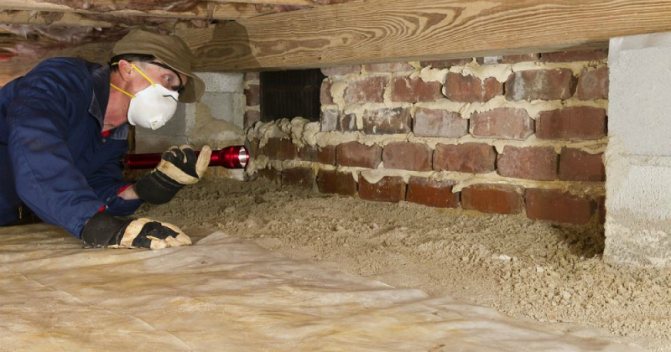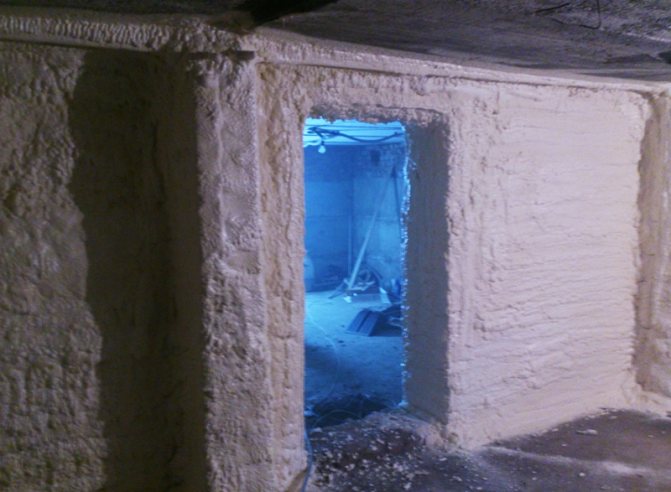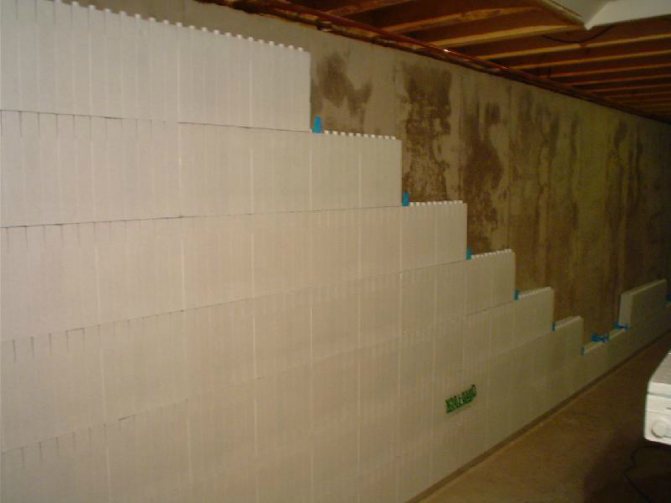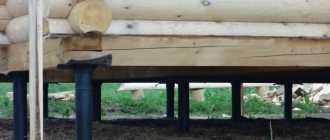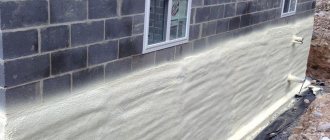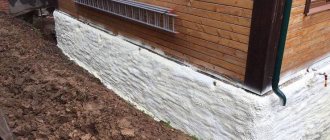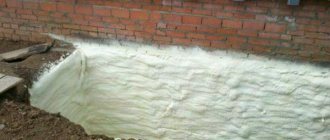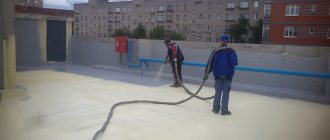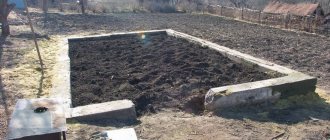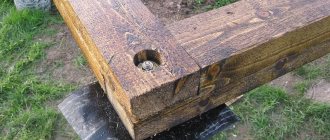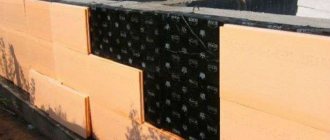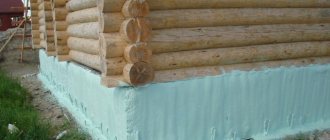Basement waterproofing is one of the most important measures that can be carried out both at the stage of building a house and after its completion. The basement part is a kind of connecting link between the foundation and the rest of the building. Therefore, its strength, stability and non-susceptibility to various influences will determine the durability and reliability of all structures of the house. During the operation of the building, in particular, with the help of the plinth, the internal premises are protected from moisture penetration.
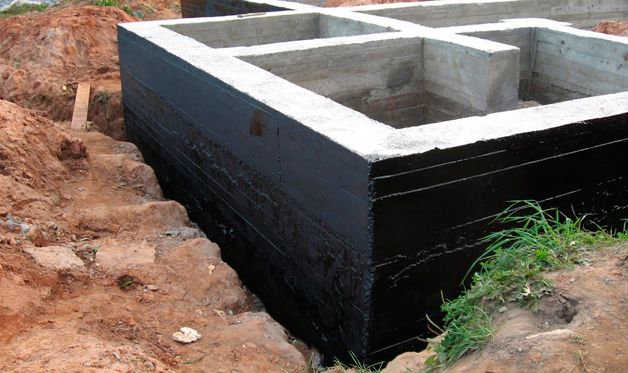
It should be noted that it is the outer part of the basement floor that is most exposed to moisture, therefore it is very vulnerable. The plinth takes on the influence of upstream water, groundwater, rain and other precipitation. There must be a reliable waterproofing and heat-insulating layer between the foundation and the upper structure of the building. This is how you need to make the basement of your house. Additionally, it is recommended to organize drainage of the site.
Insulation types
In order to reliably protect the base from moisture, it should be taken into account that the structures will have to be protected in two planes at once:
- Vertically. It is necessary to apply moisture-proof material on the outside of the walls.
- Horizontally. Moisture-proof materials are laid between the foundation and the outer part of the basement.
The horizontal waterproofing of the basement floor from the outside will exclude the penetration of moisture into the interior of the house. The waterproofing device in this case involves the use of roll materials, among which roofing material and roofing felt are more popular. It is best to choose roofing material, because roofing felt cannot provide long-term protection of the basement from moisture penetration.
The modern roofing material offered on the market is quite effective. It is made from bitumen, so it is perfect for waterproofing the outside of the building and between the foundation and the walls of the house.
Vertical waterproofing is more variable than horizontal, therefore (depending on operating conditions and other factors), you can choose a more suitable option:
- Bituminous mastics and analogues. The thick liquid mastic allows you to create a powerful protection outside (on the outside of the basement) that will have excellent performance and performance characteristics. Of course, there is no need to talk about the strength of the material here, because the hardened mastic is easily exposed to mechanical stress. Experts recommend preferring liquid glass.
- To paint the base, you can use special protective varnishes, which are distinguished by an affordable price and ease of application. These varnishes have no more advantages.
- With the help of synthetic resin or liquid polymer waterproofing materials, you can create a more or less high-quality waterproofing layer. But if effective drainage of the site is not provided, these materials will remain useless.
- The plinth from the outside can also be pasted over with roll materials. In principle, the option is good, but again, a lot here will depend on the operating conditions.
When choosing the type of waterproofing, it is necessary to take into account what materials the basement is built from, as well as what building materials are supposed to be used in the future for finishing. The horizontal waterproofing of the basement deserves special attention.
Insulation of the foundation with expanded polystyrene
Installation technology consists of sequential stages:
- preparation of the workplace.
It consists in the excavation of the foundation. The minimum trench depth should match the basement depth. Ideally, excavate the soil to the full height of the foundation. As for the width, it is determined by a simple addition of the thickness of the insulation and the width of the space necessary for comfortable work.
Advice. It is advisable to fill the bottom of the trench with expanded clay or lay a sand-crushed stone pillow. If it is expensive, then you can limit yourself to filling the space under the insulation.
- preparation of the base.
The open foundation must dry out. In the warm season, it takes about a week. Cool - up to 2 weeks. The term depends on the weather and humidity of the foundation. Dry surfaces may need additional treatment. So, large cracks should be repaired with mortar, and small ones should be blown out with foam. A seriously deformed foundation must be leveled. This will reduce the consumption of material and eliminate the possibility of unwanted air gaps between the insulation and the base;
- foundation priming.
You shouldn't ignore this step. Firstly, the primer protects the foundation from moisture, and therefore from destruction. Secondly, it increases the adhesion of the surface. Thus, the adhesive for extruded polystyrene foam will adhere more strongly to the surface.
- waterproofing of the foundation.
Papered insulation (bitumen, geotextiles), coating (mastics), plastering (based on polymer-cement mortars) are used as materials. Examples of their use in the photo.
- fastening of expanded polystyrene.
Installation is carried out using glue or foam glue for expanded polystyrene.
Advice. Additional fixing of the sheets with umbrellas is not required if the foundation is hidden by the ground. If the basement floor is insulated, then this is a prerequisite.
- finishing.
To protect the insulation from the harmful effects of ultraviolet radiation and other environmental factors, you need to close it with a finishing material. Or cover it with plastic wrap or roofing felt, and only then cover it with earth.
Penetrating waterproofing
The main advantage of penetrating waterproofing is that it penetrates deep enough into the concrete. The mixture will gradually move along miniature cracks into the concrete, clogging up all capillaries and pores through which moisture can flow. In addition, the penetrating waterproofing enters into a chemical reaction with the concrete itself, becoming a "single whole" with it.
Penetrating waterproofing will significantly increase the strength of concrete (the manufacturer notes that the strength increases by about 20-30%). In addition, concrete becomes inert to chemical attack.
The work technology is as follows:
- Penetrating insulation is presented in the form of a dry powder, which must be diluted in water and the resulting mixture is stirred to the required density.
- The mixture is applied to a damp concrete surface.
- Apply layer by layer. It is recommended to use special synthetic brushes for this.
- Processing the basement floor with these materials from the outside is allowed only at a positive temperature outside.
Warming of the foundation of different types
Having dealt with the heaters, he will briefly characterize the insulation of the foundation by its types, the main of which include:
- Tape
- Columnar
- Pile
- Pile-screw
- Plate (floating)
- monolithic tape; - shallow tape.
- deeply buried slab; - shallow slab.
In addition, the depth of laying affects the choice of insulation and the technology of its installation: strong, shallow and not buried. It is important to take into account such a parameter as the material from which the foundation is made: brick, wood, iron. The different properties of these materials lead to the fact that they conduct different amounts of heat.
Insulation of the strip foundation
This type of foundation is used in multi-storey construction or the construction of heavy structures. It is clear that only a monolithic concrete wall can withstand the weight of the structure. However, concrete is not able to retain heat inside a building. It is advisable to insulate the strip foundation at the stage of arrangement. Because digging a deep, wide and long trench is long and troublesome. The technology of insulation of a monolithic foundation of a tape type depends on the type of insulation and is given above.
The insulation of shallow foundations is somewhat different.
This is due to the depth of their arrangement. In order to prevent heat loss through a shallow foundation, it is necessary not only to insulate it vertically, but also to insulate the floor in order to exclude the possibility of freezing of the soil and the base of the house. Most often, vertical and horizontal insulation is performed using expanded clay, filling it into the pit between the foundation.
Insulation of a columnar foundation
It is considered the most reliable type of foundation. It is used in low-rise construction. In terms of the manufacturing method, it is similar to tape. But, to give it strength, concrete pillars are used. They are installed in the corners, along the perimeter of the load-bearing walls and at the junction of the internal walls. Before proceeding with the insulation of such a foundation, it is necessary to eliminate the voids between the supports. For this, foundation pickups are arranged. Wooden or metal structures that connect the supports.
Expanded clay is poured into the middle of the formed cells. Which in itself is a good insulation. Outside, the zabirki are waterproofed and pasted over with expanded polystyrene. Or polyurethane foam is applied to them. Further, the insulation is covered with a film and covered with earth or covered with a finishing material.
Insulation of the pile foundation
The specificity of this type of foundation is that the structure is erected on piles - vertical supports, covered with a concrete slab. It is irreplaceable on soils characterized by special instability. Then it becomes necessary to deepen the piles and install them on a solid foundation. On piles, a grillage is equipped, on which the building is actually being built.
The grillage can be made of various materials (see photo).
Based on the design, it is impractical to insulate the foundation on piles. However, protecting the grillage will reduce heat loss.
Insulation of the foundation grillage is carried out using any heat-insulating material that meets the requirements of reliability, strength and durability.
Insulation of the screw foundation
It would be correct to call this paragraph of the description "insulation of the pile-screw foundation"
Its specificity is in the use of screws acting as a pile. The popularity of this type of foundation has led to the simplicity and high speed of installation of screw piles. It is used in unstable soils and in the construction of temporary buildings. Further, the arrangement of the foundation is identical to the pile one. And, consequently, the insulation of the pile-screw foundation is carried out according to the same scheme. And it consists in warming the grillage. Insulating temporary buildings is most often impractical.
Insulation of the slab foundation
The essence of the slab foundation is in arranging a single monolithic slab under the entire building. This leads to a specific approach to its insulation. Namely, the entire surface of the slab must be insulated during construction. Moreover, preferably in several layers due to the proximity to the ground. The sequence of work is as follows: sand is poured onto the ground, then geotextiles, a layer of concrete, a layer of waterproofing are laid. Styrofoam is laid on this pillow or expanded clay is poured. Closed again with waterproofing. Only then can you equip the slab - the concrete base of the building.The technology of insulation and the sequence of work is illustrated in the photo.
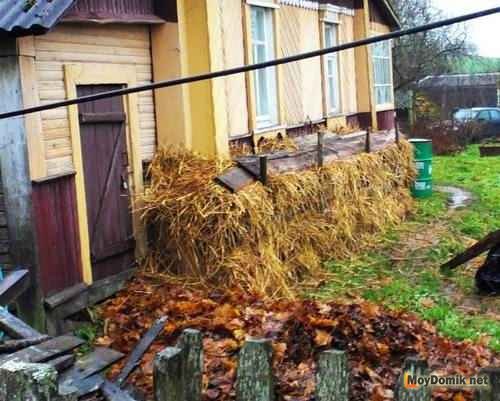

Roll waterproofing
Roll waterproofing (aka bituminous, polymer, synthetic) is applied to all basement structures of the building. As a rule, the outer parts of the walls are covered with 2-3 layers of roll waterproofing for reliability. If the building is located on an area where there is a high level of groundwater or active perching, then it is recommended to make 4-5 layers of waterproofing in order to exclude the possibility of moisture penetration into the house.
The roll insulation for the plinth is glued with an overlap, therefore, the protection of the foundation from moisture in this case is at an extremely high level. Additionally, all joints can be covered with liquid waterproofing, which will provide a very high result.
Rolled waterproofing is not resistant to mechanical stress, therefore it is recommended to additionally protect it. Despite the use of waterproofing, good drainage of the site is necessary if the groundwater is located high enough.
What methods can be used to protect the foundation?
Firstly, the installation of special ebbs for the foundation. Their purpose is to drain rain and melt water falling on the foundation from the roof. They are installed in such a way that the abutment to the wall is as tight as possible. If this cannot be done, then it is necessary to fill the joints of the ebb and the walls with a sealant.
Secondly, waterproofing the foundation from groundwater. All foundation surfaces in contact with the ground are subject to waterproofing. The methods of implementation depend on the structural features of the foundation and the level of groundwater.
In the event that the water does not rise higher than one meter to the base of the foundation, then it is quite enough to perform waterproofing with roofing material, which is laid before pouring concrete to the bottom and from the inner sides to the formwork of the future foundation. This method is applicable not only for the strip foundation, but also for the filler. Roofing material is placed on the bottom of the hole drilled for the pile, and to protect the pile around the circumference, it is rolled up with a “tube” and inserted into the hole before the concrete is poured.
Of course, this is the cheapest option, which is not quite suitable if the groundwater comes too high to the base of the foundation, especially if it is poured during floods. In this case, it is necessary to use more expensive modern materials: penetrating waterproofing or liquid rubber.
Thirdly, the foundation must be protected from surface water that falls on its unburied part during rain and snow melting. This is necessary only if facing work will not be carried out on the basement part of the foundation, with the exception of facing with panels: moisture may well get into the space between them and the foundation with destructive consequences. There is no need for waterproofing the basement part and in the case of plastering it with a special basement plaster with further painting.
For waterproofing the basement, the coating method is used. The most popular in this case is bituminous mastic. There are several ways to use it. If the surface of the foundation is free of cracks, irregularities and bulges, then the mastic is heated to 30 - 40 degrees and applied with a brush or roller. It can be heated with a torch or blowtorch. You can dilute the mastic with white spirit, but you should not get carried away with this - when you add it, the mastic cools quickly and, as a result, it will be difficult to mix it into a homogeneous mass.
Before applying the mastic, the surface must be cleaned of dirt and degreased. If there are irregularities on the foundation, then it is necessary to knock them down. Cracks and deep depressions in the foundation can be repaired with the same mastic, but without heating it.In this case, it is applied with a spatula by analogy with a putty.
When waterproofing the foundation, it is necessary to take into account that any building materials are very poorly applied to it. Waterproofing the basement part of the foundation must be performed after the blind areas are ready, which in turn also serves as a drainage of water from the foundation.
Thus, the sequence of works on waterproofing the foundation should be as follows: we perform waterproofing of the soil part, fill in the blind areas, we perform waterproofing (or finishing work) of the basement part.
To make the building more reliable and stand for a long time, you need to think about this at the initial stage of construction. Most of all building materials are porous and absorb water. Moisture dissolves salt crystals, with constant moisture and drying, a gradual deterioration of the structure of materials occurs and their strength decreases. Naturally, this reduces the strength and reliability of not only the foundation, but also the building itself as a whole. Water is a constant enemy of building materials also because when it freezes, it increases in volume up to 10%. As a result, this creates a pressure in the pores of the material in excess of 200 MPa. Even the most durable materials such as brick, concrete and natural stone cannot withstand such internal pressure and form microcracks. If you do not know how to treat the foundation from moisture, it is worth considering two options, each of which has its pros and cons.
Protection of a brick base from water
The device of a brick basement is a traditional solution for many types of country houses. You can isolate it from moisture using the following simple technology:
- Before you start laying, you need to purchase a brick that has been pre-treated with special impregnations that protect the material from moisture (of course, such bricks are more expensive, but when using the basement and the entire building, the costs pay off).
- On the surface of the masonry, after cleaning it, it is necessary to apply bituminous mastic in 3-4 layers (or any other analogue of coating waterproofing).
- Further, the surface must be covered with roll waterproofing (you can take a regular roofing material or any modern material).
- Penetrating waterproofing can also be applied if desired.
It is recommended to consult with specialists about the use of certain materials in specific climatic conditions.
Once again, we note that in any case, when installing high-quality waterproofing, effective drainage of the site is required. It is drainage and its entire system that are the key to the absence of large volumes of water in the area around the house.
Roll, coating and penetrating waterproofing, drainage and high-quality performance of all work - these are the main components of high-quality protection of the basement from moisture penetration.
Chief editor of the site, civil engineer. Graduated from SibSTRIN in 1994, since then he has worked for more than 14 years in construction companies, after which he started his own business. The owner of a company engaged in suburban construction.
How to process the foundation
Before treating the foundation with a water repellent, you need to walk over the surface with an antiseptic.
You can process the foundation from moisture by purchasing ready-made solutions or their concentrates.
The method of applying them to the surface to be treated is quite simple and does not require any special expensive tools and special skills, you can use any of the proposed tools:
- roller;
- brush;
- spray.
Any of these tools are suitable to keep moisture away. If you are not using a spray bottle, you will need a convenient container for the protective liquid.
- If you are using a concentrate, then carefully read the instructions and find out in what proportions it needs to be diluted.If you purchased a ready-made solution, you can immediately start working, but first prepare the foundation surface for processing.
- If the surface to be treated is already affected by fungus, mold, or efflorescence protrudes on it, it should be treated with special chemical solutions or antiseptics. When processing walls with loose plaster, it must be removed mechanically.
The water repellent is applied in an even, abundant layer over the entire treated surface until shine appears. With a high porosity of the material, the solution is applied in two layers, with an interval of about 10-15 minutes, for more effective protection from moisture. Most water repellents are recommended for use in dry weather, as otherwise the hydrophobic effect is reduced. The foundation must be completely saturated with a water repellent, therefore, the required amount of liquid must be calculated taking into account the porosity of the material.
Foundation elements: not only the concrete surface of the foundation can be treated with a water repellent, but also its wooden, steel or iron elements. This will also give them protection from moisture, which means from decay, corrosion and significantly increase their service life.
If the waterproofing of the foundation with your own hands is done correctly, the base of the house will turn out to be guaranteed to be durable, strong and of truly high quality.
The foundation of any residential building is considered the most important part of its structure. It is on it that heavy loads fall during operation. This means that it must be reliable. Indeed, with its destruction (even partial), other structural elements will also begin to deform.
Let's take a look at what happens to the concrete base of a residential building when it is not protected from moisture. In the warm season, the surface of the foundation is constantly moistened. A certain amount of moisture collects on it, which is absorbed into the concrete. With the onset of winter, water trapped in the foundation freezes. It expands, which causes the destruction of the (at first very insignificant) concrete structure.
Waterproofing protects the foundation from water
In the spring, frozen moisture thaws. After it, cracks and numerous pores remain in the concrete. The situation repeats itself the next year. After a couple of years, the cracks on the foundation will already be large enough and moisture will penetrate into the frame from the reinforcement. From this time on, the process of destruction of the foundation will become irreversible.
Negligent builders argue that in a number of situations (low groundwater level, minimum rainfall during the year in a particular area, and so on), it is possible not to waterproof the base of the house. It is better not to pay attention to the words of such would-be advisers.
At any time, ground movements may begin on your land plot. They will lead to a change in the position of groundwater aquifers.
Water from them may well go to the base of your house. We have already described what will happen in a few years.
Therefore, waterproofing the foundation - with your own hands or with the assistance of hired professionals, should always be performed. And here it is important to choose the right material that will reliably protect the base of the dwelling from moisture.
Moisture protection of the foundations of residential buildings is horizontal and vertical. The first of them is set up at the stage of building the foundation, and the second can be performed in an already built house. Horizontal insulation is usually done with roofing felt. Also, its variety is considered to be the arrangement of a special drainage system (it is mandatory when the groundwater is close to the surface on the site).
Horizontal waterproofing
Do-it-yourself waterproofing of the foundation with roofing material is performed as follows:
- You dig a foundation pit for the base of the house, cover its bottom with clay with a layer of about 0.25–0.3 m and tamp the material very carefully. Instead of clay, it is allowed to use. A so-called pillow is made of it.
- Apply a 6–8 cm concrete screed (a part of cement to five parts of sand plus water until a thick consistency) over a sand cushion or clay layer.
- Wait 10-12 days until the concrete hardens. After that, bituminous mastic is used. This compound should be used to process the screed made, and then lay roofing material on it.
- Apply the mastic again and cover it with a second layer of roofing material.
- Make another screed from the concrete mix (the thickness is the same as in the previous layer).
This completes the work. Do-it-yourself horizontal waterproofing of the foundation! But remember that it is then desirable to produce vertical moisture protection of the base in one of the ways that we will describe in the next section.
Now let's figure out how the drainage system is set up, a subspecies of horizontal waterproofing. It is built in two situations:
- when water accumulates under the building (it is not absorbed into the ground);
- when soil water flows at the same level as the depth of the foundation.
The procedure for performing work on the arrangement of drainage is as follows:
- You dig a small ditch 0.3 m wide around the perimeter of the house (you retreat from the building by about 0.8-1 m). The depth of the groove is taken 0.25 m lower from the level of pouring the concrete base. Note! The ditch is made with a slope (very small) towards the well, which collects water.
- Lay the geotextile at the bottom of the ditch (the material is overlapped on the walls by about 0.7 m), pour gravel (5 cm) on top and mount a drainage pipe on it. For each meter of tubular products, provide a slope of about 5 mm.
- Fill the pipe with a 25-centimeter layer of gravel, and then wrap the entire completed structure in geotextile (just lower the overlap left earlier).
The last step is backfilling the trench with soil. Do not forget to build a separate sump where the drain pipe will drain excess moisture.
Vertical moisture protection is suitable for an already built dwelling, and for one that is under construction. Such waterproofing is understood as the treatment with special compounds or materials of the walls of the foundation made.
It is performed with bituminous mastic, plaster mixture, liquid rubber, ordinary clay, penetrating solutions.
Foundation vertical waterproofing
Most often, bituminous mastic is used to moisture protection of the base of a built house. It is inexpensive and at the same time has excellent waterproofing potential. The principle of performing work with its help is given below:
- get a piece of bitumen;
- in any container, heat it to a liquid state;
- process the foundation with the resulting solution (usually bitumen mastic is applied 3-4 times).
The composition will penetrate into all existing gaps and the smallest gaps in the structure and will become a good barrier for moisture striving to penetrate into the residential building.
Bituminous mastic is also sold ready-made. It's even easier to work with her. As a rule, the finished composition does not need additional heating. Yes, and such mastic is applied not 3-4 times, but a maximum of two layers.
Important! Every 5-7 years, the foundation must be re-treated with a bitumen composition.
Penetrating solutions for moisture protection - Penetron, Aquatro and others - have great durability. They should be applied to a foundation that is free of dust (additionally, it should be slightly moistened before direct use of the penetrating composition). The solution impregnates the base structure by 12-15 cm and effectively protects it from moisture.
Penetrating insulation is not yet very common in our country because of its novelty and rather high cost.At the same time, it protects the foundations from water much better than the bitumen mastic familiar to domestic home craftsmen.
Elastopaz and Elastomix formulations are excellent water defenders of the vertical type. They are liquid rubbers, ideal for independent work on moisture protection of foundations of private residential buildings. The rules for their use are simple:
- The base of the building is processed with Elastopaz twice, Elastomix - once.
- The foundation is processed with a roller or with a wide paint brush. To speed up the work, it is allowed to use a spray device.
- Before using liquid rubber, the base of the house must be treated with a primer.
- Unused Elastopaz can be stored until the next work. But Elastomix is applied once. If you did not use all of the composition from the package, the rest will have to be thrown away.
Waterproofing with liquid rubber
The disadvantages of these waterproofing materials include their high cost and long duration of work (the process of applying liquid rubber to the foundation takes a lot of time). Moreover, such formulations are very effective and durable. Let us add that the consumption of liquid rubber for processing one square of the base is about 3 kg.
If you do not want to spend money on the purchase of expensive compounds, perform waterproofing of the foundation with an ordinary plaster mixture. Just add special hydro-resistant polymer elements to it (they are available in a large assortment in any building store).
It is necessary to attach a putty mesh to the foundation (dowels are usually used to fix it), and then process the structure with plaster. The result of such work will be both high-quality moisture protection of the base of the building, and its simultaneous leveling. The application of the plaster mixture is carried out with a spatula - this procedure will not cause any difficulties for a home craftsman.
The disadvantages of using plaster for waterproofing include the comparative fragility of the insulating layer (maximum - 12-15 years) and the risk of cracking on the treated surface. But such a composition is worth mere pennies, and the speed of doing such work with your own hands is very high.
Finally, let's talk about the simplest and cheapest way to protect foundations from moisture. It is called a clay castle. The rules for its arrangement are as follows:
- Dig a shallow (up to 0.6 m) ditch around the existing foundation.
- Fill in gravel or crushed stone at the bottom of the ditch (a layer of about 5 cm).
- Place clay on top and tamp it carefully. Add clay several times.
The resulting clay lock acts as a buffer that retains moisture and prevents it from penetrating under the house. This method is ideal for a building that has already been built and has been in use for a long time. True, experts do not advise using it for waterproofing residential buildings. It is more suitable for outbuildings.
As you can see, there are many methods for protecting the foundations of various buildings from excess moisture. You just need to choose the appropriate option and start independent work.
How to protect concrete from moisture? In this article, we have to analyze several popular solutions that are applicable both for waterproofing foundations and basements, and for protecting capital walls from precipitation and seasonal fluctuations in humidity.
Our goal is to make concrete hydrophobic.
Polyurethane mastics for foundation protection
From time to time, TV channels tell us how a whole house or part of it suddenly collapsed somewhere. We do not want to scare you, as idle TV people do. But let's say that there is no "sudden" in the case of the destruction of a building. Any structure starts from the foundation and rests on it. If it is not strong enough and moisture resistant, then the house will not stand for a long time.The most common causes of foundation destruction are dampness, moisture, loose and water-saturated soil, heterogeneous soil, the beginning of the construction of a new house or a road nearby. It only seems that the foundation is heavy and will withstand everything. No, it is, first of all, a movable structure that is sensitive to any load and changes in the environment. Polyurethane mastic will help protect the foundation from destruction.
How to understand that your foundation is in danger
There are several signs that can help you identify the problem in the first step. Usually, thin cracks, spots, mold on the walls inside the house, distortions of door and window structures appear on the foundation, then the external finish begins to collapse, the floor deforms, some parts of the building collapse, the soil falls along the structure. If you notice cracks, it is worth checking the stability of the base.
The most common problem in Russian latitudes is excess moisture. Usually concrete is used for the foundation. It is a porous material that can take in some water. But if there is too much of it, then the concrete cannot cope. In addition, moisture can linger inside, freeze and thus destroy the material.
Which waterproofing to choose
There are several main types of waterproofing. To choose the best option for you, you need to understand what type of soil you are dealing with, how deep the groundwater goes, at what depth the foundation is located, what it is made of, what size the building is.
There is one simple way to check how deep the groundwater goes. In the spring or fall, dig small holes where you plan to build your house. And look to what level the water reaches in them. This will determine how deep the foundation can be set.
If you notice that there are many marsh plants and sedges near the site, then the water is close.
We decided to arrange a basement or basement, which means that waterproofing is needed for sure.
Very often in such cases, vertical insulation is used together with bitumen-based roll materials. Another option is coating insulation. In this case, polymer compositions are applied to the surface of the foundation. Some recommend using both for maximum protection.
Polyurethane mastic or bitumen?
There are many types of waterproofing compounds on the market. With the development of the chemical industry, these products are becoming more and more perfect. Whereas previously it was possible to rely only on bitumen, now there are more durable alternatives to it.
What is the difference between bitumen and polyurethane mastic? Bitumen is one of the oldest building materials available and cheap. Polyurethane mastics appeared on the market not so long ago, but they are distinguished by their strength and elasticity, which persists for many years. Bitumen loses these properties very quickly. Its strength is enough for several years, then the physical and chemical properties of the material weaken. Polyurethane mastics can last more than 40 years.
Polyurethane mastic from "Khimtrast"
has developed its own polyurethane mastic, which can be used not only for waterproofing foundations, but also for roofs, pools, tanks, basements, terraces, balconies, tunnels, as well as under screeds and tiles, for repairing old bituminous insulation.
Mastic "Chemtrast PUMA (1k)" is available for purchase in wholesale and retail volumes. If the surface for waterproofing is not so large and you need to make minor repairs, then you can buy a liter or three-liter jar of mastic. You pay for the purchase through the online store on the company's website, then the product arrives at your home. You save your time on trips to hardware stores, markets and queuing.
You can also order the color of the mastic that best matches the color of your home. In this case, the indicator of moisture resistance will remain unchanged. High adhesion allows you to protect almost any surface from external influences.
How to work with polyurethane mastic
The concrete foundation on which you plan to apply the mastic must be clean, without breaks and cracks, without sharp joints. If you notice bubbles on the concrete, then its surface must be sanded and then cleaned of dust and dirt. It is also necessary to get rid of moisture from the foundation. The best time for work is a sunny dry day without precipitation.
How to check if the surface is dry enough? A few hours before applying the mastic, place a small piece of polyethylene on the surface of the concrete and check for condensation. If it is not there, then you can start work.
For better adhesion, the company's specialists recommend applying a primer to concrete - "Chemtrast Primer-PM (1k)". One coat of primer should be sufficient. An hour after that, you can start applying the mastic. Before use, the material must be mixed using a mixer with a spiral nozzle.
Then take a roller or paint brush and apply the first coat of polyurethane mastic from top to bottom. The layer should not be thick, literally 1-2 millimeters. After a day, you can add a second layer of thicker mastic. Use aliphatic mastic to protect the surface from UV rays.
When working with polyurethane mastic, observe safety precautions, work in a gas mask or protective mask, in special clothing that will cover all parts of your body.
After work, rinse all brushes with acetone, and store the mastic in a tightly closed container so that polymerization does not occur.
Experts are always ready to tell you which polymer is best for your purposes. Our warehouses can be found in Novosibirsk, Irkutsk, Yekaterinburg, Krasnoyarsk, Voronezh, Yaroslavl, Nizhny Novgorod, Moscow, St. Petersburg, Samara and Ufa.
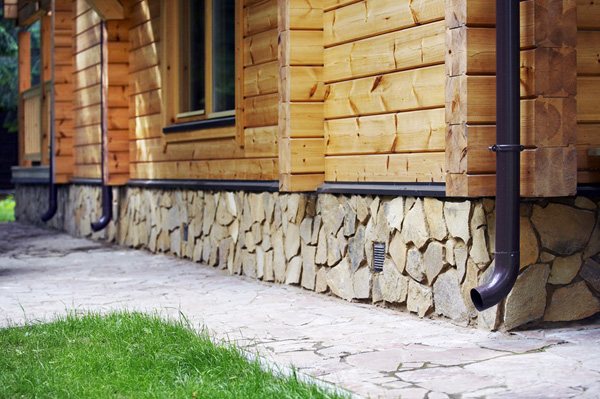

The plinth protects the walls of the building from the penetration of ground moisture into them and, as a result, their destruction. But what will the base itself protect? Surely this is done correctly. finishing the basement of the house, which only in the second place performs decorative functions, and in the first place - a protective role. It is this issue that we will deal with in the current article, in which, together with the site stroisovety.org, we will deal in detail with how to properly coat the basement of a building so that it is completely protected from aggressive environmental influences and, moreover, has an attractive appearance.
Wet foundation
Good day! Please tell me how to cope with the problem! The foundation in a wooden house was redesigned. They made it 70 cm deep and 30 cm high from the ground. They did it in a dry year, there was no water there. Now a neighbor has dug a pond, a water reservoir, plus groundwater. On the inside of the house, condensation is now constantly present on the plinth. Mold has appeared in the underground, the house smells like mold, things lying close to the floor are covered with mold. Is it possible to close it with something from the inside?
try to make waterproofing from bitumen and roofing material. it should help. only after the end of the work, check everything properly so that there is no air. otherwise the roofing material will crack
It is urgent to make a coating waterproofing of the basement from the inside.Before waterproofing, the places with mold must be thoroughly cleaned, and then treated with a composition against mold and mildew (in extreme cases, you can treat it with whitish or bleach solution). ... Around the house it is necessary to make blind areas. Also in the basement it is necessary to make ventilation windows to ventilate the room.
good afternoon Svetlana, well, if a neighbor dug a pond, this does not mean that he is to blame for everything, but anything can happen. Most likely your groundwater rises from time to time, and most likely you have no air problems. decide you need to call knowledgeable people and identify the reason. Thank you
Good day! Most likely, your neighbor has nothing to do with it. The reason is probably poor ventilation of the basement. The fact is that it is either mold or not. it is almost impossible to remove it. Try to clean it with "Whiteness", and after drying, treat the damaged surface with a solution of copper sulphate "this old old-fashioned way is better than modern chemicals". But without ventilation, everything will go back very quickly.
Make drainage wells at the corners of the building, 3m deep and connect them with pipes if it gets damp further. install a drainage pump in one well Kid with a float switch for automatic pumping of water
Good afternoon, Svetlana. First of all, mold is moisture and if mold forms, it means there is a lot of humidity. As you have already recommended, this is the ventilation of the lower layers (air vents). But this is not the most important thing. You need to remove the moisture itself. There should be drainage around the house if it is not there, then you need it do. Further, the foundation waterproofing itself must necessarily be.
The only advice I have read that is worthwhile, 101% agree.
Is there any air in your foundation?
Make wall drainage along the perimeter of the building (at the level of the bookmark below the floor in the basement by 20-30 cm), drain water from the drainage (for example) into a pumping well, thereby you will drain water from the house. As recommended by other masters - the air vents and the blind area - everything in the complex will give the desired result. Waterproofing from the inside is pointless.
Nice drainage). Only, it hurts too shallow, they forgot about the depth of freezing. In the Moscow region it is 1.5 meters. Your drainage will freeze in winter. Unfortunately
answer for Vyacheslav Feshchenko - The drainage in the photo has been working for 3 years without any problems (I can give the phone number of the customers of this drainage) and does not freeze, the technology must be followed and everything will be OK! By the way, the drainage shown in the photo serves as a surface drainage and serves to drain the site and not the basement. Do you want examples? Write - I will be happy to invite you to view at any of our facilities. You will be able to see both surface and deep drainages (occurrence over 3 meters). Write, I think that professionals can always be useful to each other.
Thank you all for the recommendations! I want to clarify what there is: there are two windows for ventilation, there is no obvious mold in the underground, but the racks for vegetables smell of mold, and the vegetables of the code start to smell after a while. Floor boards and cuts from the inside are processed by working off. Concrete pouring from the outside and from the inside is treated with a special solution for concrete (if you need to clarify the name) and bituminous mastic, which within two years from the inside of the pouring (as the foundation was redone) cannot dry out and condensate accumulates on it. Until the hands have reached the blind area.
Condensation that forms on the plinth is the reason. The lower ground level than outside the building. If possible, raise the surface from the inside of the plinth. 20 cm higher. And the mold smell will disappear.
Sergey, do you need to fill up the whole area? Or enough near concrete? And is it necessary to close it in front of these with something, maybe with some material?
The filling should be done over the entire area. If only from severe frosts the soil freezes from the inside, then you will have to do the basement insulation.
Finishing the basement of the house: how to make waterproofing
Oddly enough, but before proceeding with the immediate finishing plinth foundation houses, you need to execute it waterproofing... For what? The answer is still the same - protection from moisture, which can seep not only through the soil, but also through the seams of the facing material.In general, the waterproofing of the basement should be carried out at the stage of building the foundation, but, as a rule, everything is limited to insulating only its underground part, which is mainly performed with roofing material or bitumen mastic. In fact, these materials interfere with further finishing the basement of the house, and they seem to be ignored, or, at best, released 10-15 cm above ground level. In principle, this is quite enough to protect the foundation from destruction, but not the basement of the structure.


Finishing the basement of the house do-it-yourself stone photo
FROM waterproofing the basement of the house things are a little different - roofing material, bituminous mastic and similar materials will not work here. Almost all materials for finishing the basement of the house require a different type of base - therefore, the requirements for waterproofing the basement of the building are slightly different.
Types of insulation for foundations - characteristics and properties
Various materials can be used to insulate the foundation. We offer to rank them by cost:
Sand
Warming takes place during the construction phase of the house. This is the cheapest way to insulate. Unfortunately, its effectiveness tends to zero. Because sand is incapable of retaining heat.
Expanded clay
This material is not able to accumulate moisture. The technology of warming the foundation in this way has two directions.
Firstly, expanded clay can be poured into the middle of the formwork, even at the installation stage. This method simplifies pouring, reduces concrete consumption, and increases the thermal insulation properties of the foundation. But it makes it more fragile.
Secondly, expanded clay is poured inside the strip foundation. Thus, a lot of it is poured, and the result is a decrease in heat loss not only through the foundation, but also through the floor of the house or basement.
Styrofoam
In the language of professionals, it is called PSB (non-pressed suspension expanded polystyrene) or PSB-S (self-extinguishing suspension suspended polystyrene). This is reflected in the labeling of the material. It is a sheet of balls. There is air inside the balls, which ensures the thermal insulation properties of the material. Insulation of the foundation with foam can be attributed to the most popular type. This is due to such characteristics of the material as low thermal conductivity, absolute non-hygroscopicity. As well as cheapness, availability, and ease of use.
Penoplex
The scientific name is extruded polystyrene foam. As you can see, the names of penoplex and polystyrene are similar, and reflect the technology of their manufacture. At the same time, the technology of its manufacture is more complicated. But penoplex can be called more progressive than foam. Because it is devoid of its major disadvantages. The material is denser, which means it has greater mechanical compressive strength. It does not sustain combustion. The period of its decay in the ground is at least 100 years. The groove-comb system simplifies installation and eliminates the presence of seams.
Of the minuses, one can name the fact that insulation of the foundation with foam is more expensive than foam.
Polyurethane foam (PPU)
The most expensive, but also the most effective way to insulate the foundation today. Warming the foundation with polyurethane foam is simple. This sprayed insulation is simply sprayed onto the wall. The use of polyurethane foam avoids many steps. For example, sealing joints, leveling the base. In addition, when using this heat-insulating material, insulation and waterproofing of the foundation can be carried out at the same time.
Based on the popularity of both types of expanded polystyrene, let us dwell in more detail on how to produce thermal insulation with extruded polystyrene foam.
How to decorate the basement of the house: materials for finishing the protruding part of the foundation
Materials with which modern builders can perform finishing the basement of the house, quite a lot - these include natural and artificial stone, siding, special facade panels, tiles, clinker bricks, bassoon and even ordinary or decorative plaster. In principle, this list can be continued and continued, but there is little sense in this - all the same, the decoration of the basement with these materials is almost identical.
By technology finishing the basement of the house all materials can be divided into two groups - which require a frame for their installation and which do not need it. Frame materials include all kinds of siding, fiber cement and other panels, for the installation of which you will need to arrange a metal frame. If we talk about such materials in more detail and consider their installation technology, then we can note one feature concerning the preliminary stage of waterproofing - here the choice of insulating materials is not limited. Bitumen, roofing material, and similar materials are also suitable.
The disadvantage of this option finishing the basement of the house is the high cost of the materials themselves and the work associated with their installation. For example, fiber cement panels are one of the most expensive materials today, and their main advantage is durability.
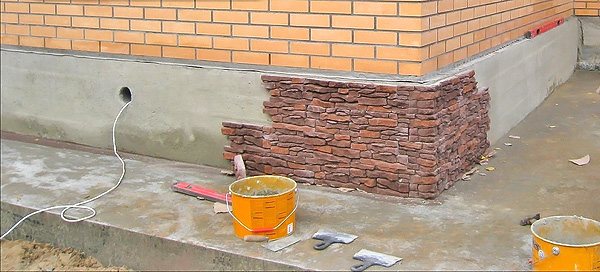

Finishing the basement of the house a photo
In financial terms, the most profitable material for a basement is all kinds of tiles, clinker bricks and stone of artificial or natural origin. The advantage of these materials lies in a fairly simple installation technology - for example, finishing the basement of the house with artificial or even natural stone, it is quite simple to do it yourself. The same can be said about tiles and clinker bricks - knowing the technology of working with tile material, revealing the foundation with any such products will not be difficult.
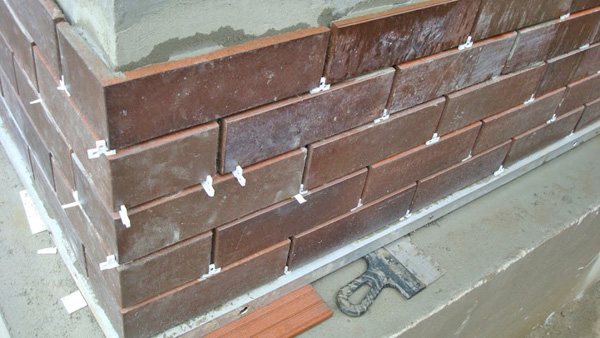

Materials for finishing the basement of the house
Additional protection for the tiled basement of the house
As the saying goes, there is a silver lining - having protected the basement of the building, it is also necessary to protect the cladding itself from the ubiquitous moisture. No matter how ridiculous it may seem, such a situation really takes place. The fact is that rain and melt water, flowing down the walls of the house, can flow and be absorbed into the solution or adhesive composition, with the help of which the basement was finished with natural stone or something else.
As a rule, either the same finishing material or special cornices made of painted galvanized steel are used as such protection. If you deal with the quality of such protection, then it is better to give preference to galvanized steel - it is more reliable. If moisture can still seep into the seams between the finishing material, then, in principle, it is not able to penetrate under the cornices.


Cornice on the basement of the house photo
The eaves are attached as follows - first, a slot is made in the wall 1.5–2 cm deep to the width of the grinder's disk, into which the bend of the eaves is inserted. After that, the cornice itself is attached to the wall with dowels, and the cut slot is sealed with a sealant. If you correctly do the docking of individual cornices, then finishing the basement of the house artificial stone (or whatever you use there for these purposes) will be reliably protected from rain and melt water.
In general, be that as it may, but finishing the basement of the house is a necessary construction activity that must be carried out in conjunction with other means of protection of the foundation (drainage of the foundation, its waterproofing and the device of the drainage system).
What is internal foundation protection
It is done at the stage of laying the future foundation. As a rule, the essence of protection is the correct choice of concrete mix, as well as an increase in its characteristics by adding special ingredients.
Nowadays, chemical modulators are popular, and it is recommended to buy and use them judiciously.For example, lignosulfonate is used to protect concrete from groundwater with a high sulfate content.
Also, the destruction of the cement base can be stopped using amorphous silica. This is a common modified sand, produced by chemical methods and is characterized by high hygroscopic properties.
Silica in concrete replaces calcium oxide and forms silicates that are resistant to acids and alkalis. And the use of electrolytic additives accelerates the process of concrete hardening and the set of brand strength by it, neutralizes oxides.
The most popular and cheapest are soda ash, potash and alkali metal hydrocarbons.
In the construction of foundations, where it is necessary to obtain high structural strength below the depth of soil freezing, chemical additives with a plasticizing effect are actively used.
Mylonaft improves waterproofing performance and frost resistance, and sulphite-yeast mash promotes rapid hardening. The organosilicon solution GKZH-94 increases frost resistance three times at once.
